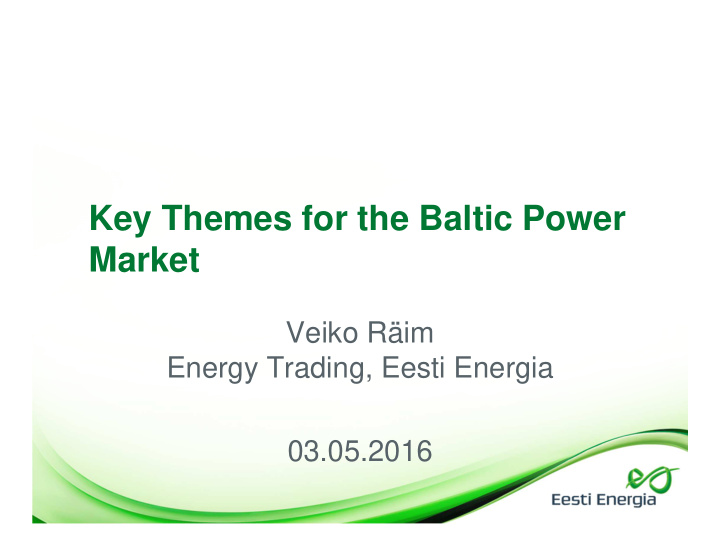



Key Themes for the Baltic Power Market Veiko Räim Energy Trading, Eesti Energia 03.05.2016
Post NordBalt Attention Needed on Border Capacity Allocation Power Prices in Nordics/Baltics • Introduction of NordBalt and LitPol in 75 2015/16 • Welcome upcoming new connections 60 between EST/LAT and LIT/POL by EUR/MWh 2020 45 – Baltic market integration increasing but also more sizeable electricity transit to Poland 30 • Predictable capacity allocation on the 15 borders of paramount importance for modelling the power market 0 – LitPol off-peak capacity allocation 15 - 15 - 15 - 15 - 16 - 16 - – NordBalt intraday capacity allocation Jan Apr Jul Oct Jan Apr (example 20.04.16) SE4 FIN EST • Regulators´ vigilance required to LAT LIT POL guarantee transparent and effective marketplace 2
LIT-POL and SE4-POL Off-peak Capacity Limitations 3
Extended Family of FTRs Needed • Baltic market EPADs limited to FTRs on Estonia-Latvia allow for meaningful hedging border • Retail market customers 1200 MW, Estonia-Latvia border interested in fixed prices for term 1000 longer than a year 800 • Extended introduction of 600 capacity FTRs/PTRs would allow more 400 competition in retail market 200 – EST-LAT FTRs in principle work well, increased size and longer duration 0 needed (say 200 MW for 2-3 years) Month Quarter Year 2 years 3 years – Introduction of NordBalt and LitPol ahead ahead ahead ahead ahead FTRs urgently needed Monthly FTRs Quarterly FTRs – In longer term bottleneck may appear on FIN-EST border Annual FTRs Extended FTRs • TSOs constant attention needed Total capacity on the evolving topic 4
Non-EU Imports’ Impact on Finnish and Baltic Power Prices • Clash of power market models between Russia and EU • Cheaper power in Russian off- peak (sometimes also within the week, e.g. March 8) influences Finland and the Baltics • Instead of Lithuanian export tariff introduced in 2016, dynamic Baltic (and perhaps Baltic/Finnish) export-import tariff needed to address current limitations 5
Conclusion • Regional power market facing new bottlenecks and increased interdependence after NordBalt and LitPol • Important that regulators take a close eye on application of transparency rules and conditions, which are applied on cross-border electricity trading • Given the increasing fluctuation of prices and persisting client preferences, further development of financial electricity market instruments should remain a priority for TSOs • Right time for a comprehensive review on the EU/Non-EU border mechanism, including an introduction of dynamic export-import tariff taking into account Baltic and Finnish experience 6
Recommend
More recommend